Although there are 13 known types of Ehlers-Danlos syndrome (EDS), a congenital disorder of the connective tissue, definitive diagnosis remains elusive in many cases. Why? With hundreds of potential causative mutations in genes of the collagen and supporting structures, not every patient displays a known pathogenic mutation on panel testing – even when clinical criteria for EDS are met.
In a new study of classical EDS (cEDS), one of the most common types, researchers sequenced genomic DNA from 59 Polish patients (1). Analysis of 35 connective tissue-related genes via next-generation sequencing (NGS) revealed 20 patients with molecular changes in the COL5A1 gene (seven pathogenic or likely pathogenic; 12 benign or likely benign; one unknown), one with COL5A2 changes (likely pathogenic), three with COL1A1 changes (two likely pathogenic; one benign), and six with COL1A2 changes (all unknown). All four genes are known to be related to cEDS. The remaining 29 patients showed no molecular changes in the genes interrogated – further testament to the condition’s phenotypic and genotypic complexity.

It’s clear that, between the disorder’s genetic variability and its overlap with other connective tissue disorders, diagnosis presents a challenge and single-gene testing is often unable to offer conclusive answers. Not only do many patients who meet clinical diagnostic criteria for cEDS exhibit no detectable pathogenic mutations, but others who do possess such mutations may not display a phenotype that meets clinical criteria. Joint hypermobility, skin extensibility, and abnormal scarring – three key diagnostic criteria for cEDS – are often present in other types of EDS and in other connective tissue disorders, muddying the waters when attempting to establish the cause of a patient’s complaints. The authors point to their study as evidence that not all causative genes for EDS have yet been elucidated – and suggest that NGS in combination with panel testing can offer diagnostic support in complex cases.
References
- A Junkiert-Czarnecka et al., Curr Issues Mol Biol, 44, 1472 (2022). PMID: 35723357.




